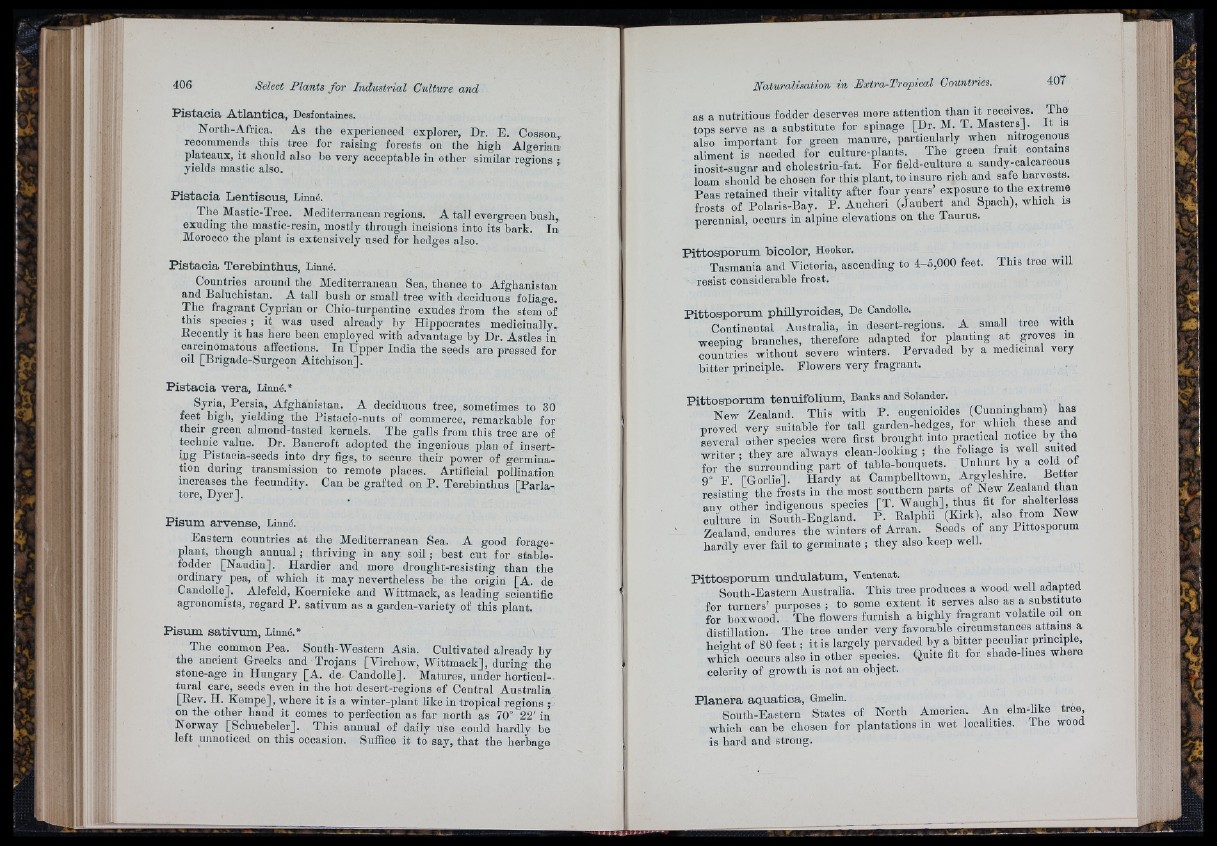
i ^
fo
I I 7 ’ I
Ii ,ll
Pistaoia Atlantica, Desfontaines.
North-Africa. As the experienced explorer. Dr. E. Cosson,.
recommends this tree for raising forests on the high Algerian
plateaux, it should also be very acceptable in other similar regions •
yields mastic also. ’
Pistaoia Lentiscus, Linné.
The Mastio-Troe. Mediterranean regions. A tall evergreen bush,
exuding the mastic-resin, mostly through incisions into its bark. In
Morocco the plant is extensively used for hedges also.
Pistacia Terebinthus, Linné.
Countries around the Mediterranean Sea, thence to Afghanistan
and Baluchistan. A tall bush or small tree with deciduous foliage.
The fragrant Cyprian or Chio-turpentine exudes from the stem of
this species ; it was used already by Hippocrates medicinally.
Recently it has here been employed with advantage by Dr. Astles in
carcinomatous affections. In Upper India the seeds are pressed for
oil [Brigade-Surgeon Aitchison].
Pistacia vera, Linné.*
Syria, Persia,^ Afghanistan. A deciduous tree, sometimes to 30
feet high, yielding the Pistacio-nuts of commerce, remarkable for
their green almond-tasted kernels. The galls from this tree are of
technic value. Dr. Bancroft adopted the ingenious plan of insert-
içg Pistacia-seeds into dry figs, to secure their power of germination
during transmission to remote places. Artificial pollination
increases the fecundity. Can be grafted on P . Terebinthus [P a rla tore,
Dyer],
Pisum arvense, Linné.
Eastern conntries at tbe Mediterranean Sea. A good forage-
plant, though annual ; thriving in any so il; best cut for stable-
fodder [Naudin]. Hardier and more drought-resisting than the
ordinary pea, of which it may nevertheless be the origin [A. de
Caudolie]. Alefeld, Koernioke and Wittmack, as leading scientific
agronomists, regard P . sativum as a garden-variety of this plant.
Pisum sativum, Linné.*
The common Pea. South-Western Asia. Cultivated already by
the ancient Greeks and Trojans [Virchow, Wittmack], during the
stone-age in Hungary [A. de Candolle]. Matures, under horticultural
care, seeds even in the hot desert-regions of Central Australia
[Rev. H. Kempe], where it is a winter-plant like in tropical regions ;
on the other hand it comes to perfection as far north as 70° 22' in
Norway [Schuebeler]. This annual of daily use could hardly be
left unnoticed on this occasion. Suffice it to say, that the herbage
as a nutritious fodder deserves more attention than it receives. The
tops serve as a substitute for spmage [Dr. M. T. Masters]. I t is
also important for green manure, particularly when nitrogenous
aliment is needed for culture-plants. The green fruit contains
inosit-sugar and cholestrin-fat. For fleld-culture a sandy-calcareous
loam should be chosen for this plant, to insure rich and safe harvests.
Peas retained their vitality after four years’ exposure to the extreme
frosts of Polaris-Bay. P . Aucheri (Jau b e rt and Spach), which is
perennial, occurs in alpine elevations on the Taurus.
P i t to s p o r u m b io o lo r, Hooker.
Tasmania and Victoria, ascending to 4-5,000 feet,
resist considerable frost.
This tree will
P i t t o s p o r u m p b illy r o id e s , De Candolle.
Continental Australia, iu desert-regions. A small tree with
weeping branches, therefore adapted for planting a t groves in
countries witliont severe winters. Pervaded by a medicinal very
bitter principle. Flowers very fragrant.
P i t t o s p o r u m te n u i f o l iu m , Banks and Solander.
New Zealand. This with P . eugenioides (Cunningham) has
proved very suitable for tall garden-hedges, for which these and
several other species were first brought into practical notice by the
writer ; they are always clean-looking ; the foliage is well
for the surrounding part of table-bouquets. Unhurt by a cold of
9° F. [Gorlie]. Hardy at Campbelltown, Argyleshire. f e tte r
resisting the frosts in the most sonthern parts of New Zealand than
any other indigenous species [T . W a u g h ] , tlms fit for shelterieM
cufture in Sonth-England. P . Ralphii (Kirk) also from New
Zealand, endures the winters of Arran. Seeds of any Pittosporum
hardly ever fail to germinate ; they also keep well.
P i t t o s p o r u m u n d u l a t u m , Ventenat.
South-Eastern Australia. Tliis tree produces a wood well adapted
for turners’ purposes ; to some extent it serves also as a substitute
for boxwood. The flowers furnish a highly fragrant volatile oil on
distillation. The tree under very favorable circumstances attains a
height of 80 feet ; it is largely pervaded by a hitter peculiar principle,
which occurs also in other species. Quite fit for shade-liues where
cslerity of growth is not an object.
P l a n e r a a q u a t i c a , Gmelin.
South-Eastern States of North America. An elm-hke tree,
which can be chosen for plantations in wet localities. The wood
is hard and strong.